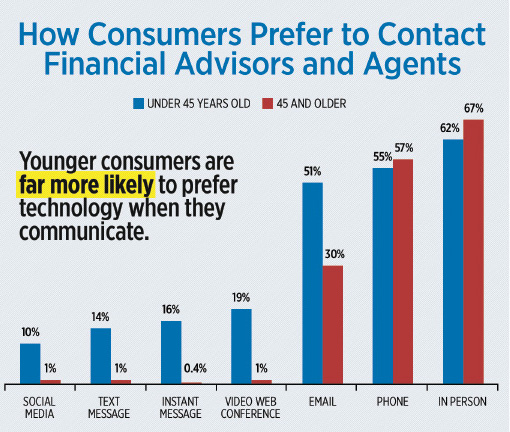Different communications are methods needed for different clients






Different people learn and comprehend in different ways, and different sorts of clients need different sorts of communications methods and styles if messaging is to be truly effective.
One size really does not fit all.
A Little while ago LIMRA did some research on preferred methods of communications by clients, and there are distinct differences across generations. That can of course be broken down much further, but the generational divide is sufficient to make the point. Broken down into just 2 simple (and big) segments there are stark differences between:
a. Those under 45 years of age
b. Those over 45 years of age
Executive summary of the research: those under age 45 are far more likely to prefer technology for communications.

Actually though, I think there is just a little bit more to this….clearly there is a majority preference in older age groups for a human conversation – whether that is in person or over the phone there is a distinct preference to talk to a human being – and that is no massive surprise. Maybe that’s why people my age rage at customer service hotlines that are a frenzy of pushing numbers and hashtags without ever contacting a live human.
The real insight for me from this graph is not that the Under 45’s prefer to use technology, but the reason behind that observation. WHY do they prefer to use technology?
I suspect it is nothing to do with the technology or particular communications channel chosen in the main. It is about speed mostly.
For the younger segment I believe the preferences are driven by their expectation of speed of response together with them feeling in control of the conversation. They can respond and react at THEIR leisure…but they got the information they wanted quickly. This explains why so many still like email despite their prevalence for “chat” and “texting” for personal communications with their peers. Email still matters for them in business.
So my take on this is if you were going to have two broad ways of tackling these very very large market “segments” would be:
a. for younger people: get lots of relevant information – not meaningless guff – to them fast. Then let them choose the pace of engagement thereafter – but maintain a presence while they digest it. Be prepared to spend time waiting.
b. for older people: Get them an executive summary of the relevant information fairly quickly, and then follow up with a conversation explaining it fairly fast. Be prepared to spend time talking.
Whether you agree with my assessment or not doesn’t really matter though. What matters is that YOU figure out what YOUR clients want in the way of communications methods and speed and then deliver accordingly. Because if you don’t, there are thousands of competitors in the global economy who will…
Comments (2)